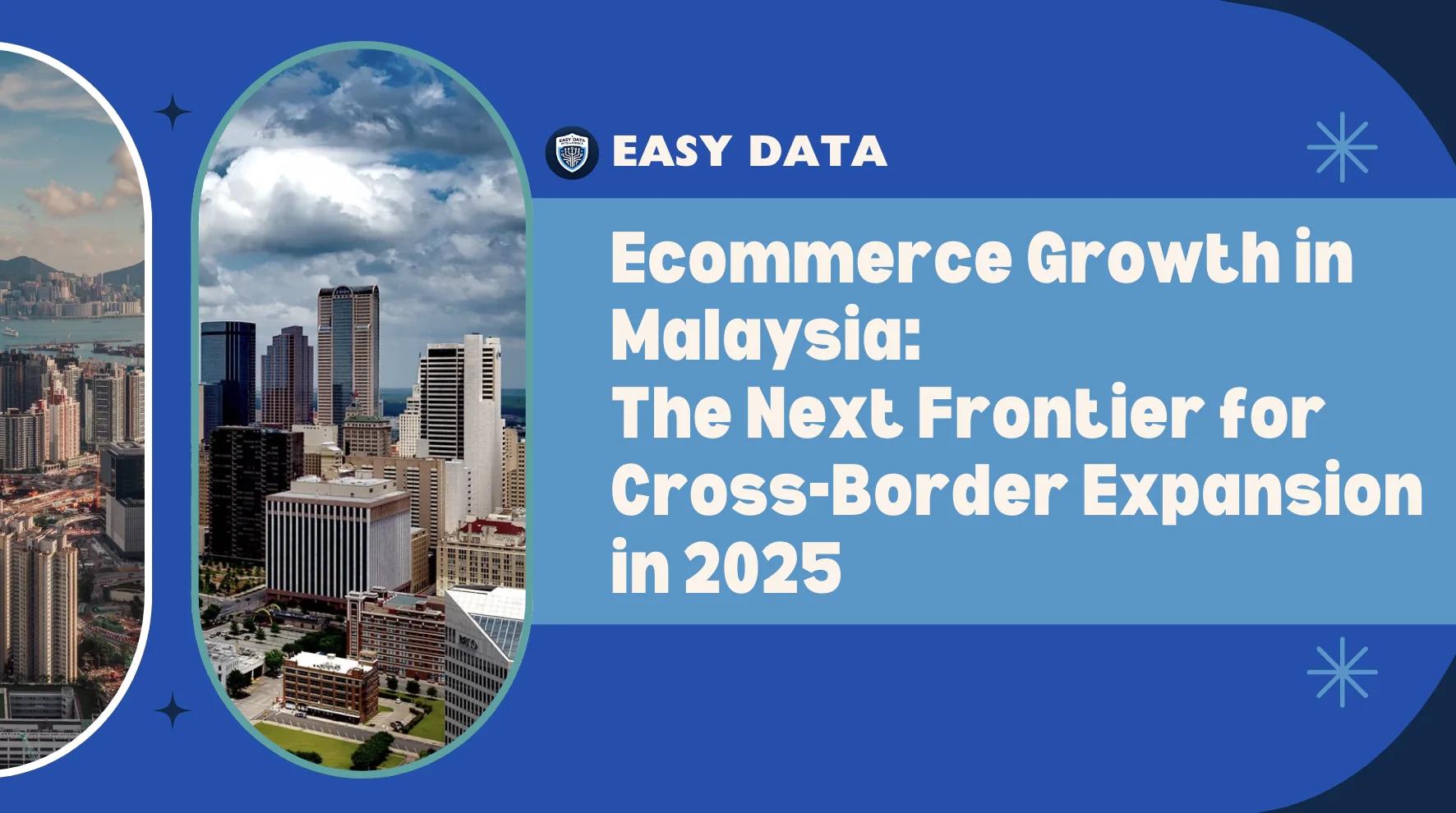Introduction
The ecommerce growth in Malaysia is accelerating rapidly, making it a prime destination for cross-border expansion in Southeast Asia. Malaysia’s strategic location, well-developed logistics infrastructure, and government incentives position it as a central hub for international businesses looking to expand in the region.
With its digitally savvy consumers and increasing demand for cross-border shopping, ecommerce growth in Malaysia presents massive opportunities for retailers and investors. In this article, we explore the key drivers, challenges, and strategies for leveraging Malaysia’s ecommerce market for international growth.
For real-time market insights and ecommerce data, visit Easy Data for in-depth analytics.
The Current Landscape of Ecommerce Growth in Malaysia
Market Size & Growth Potential
Malaysia’s ecommerce market was valued at $10.5 billion in 2023 and is expected to reach $17 billion by 2025, according to Statista. This growth is fueled by:
- 80% internet penetration, one of the highest in Southeast Asia.
- A strong mobile-first economy, with over 30 million mobile connections.
- Government initiatives such as MyDIGITAL and Malaysia Digital Economy Blueprint promoting digital commerce.
Key Players Driving Ecommerce Growth
- Shopee Malaysia: The market leader, accounting for over 50% of total ecommerce transactions.
- Lazada Malaysia: Backed by Alibaba, focusing on logistics and brand partnerships.
- Zalora & FashionValet: Leading platforms in fashion ecommerce.
- PG Mall: A local platform catering to domestic sellers and SMEs.
Why Malaysia is Becoming a Cross-Border Ecommerce Hub
1. Strategic Location for Regional Trade
Malaysia’s geographical advantage makes it a natural gateway for businesses expanding into Indonesia, Thailand, Singapore, and Vietnam. Major global brands and ecommerce platforms use Malaysia as a distribution hub due to its proximity to key ASEAN markets.
2. Strong Logistics & Fulfillment Infrastructure
Malaysia’s advanced logistics ecosystem supports both domestic and international ecommerce shipments. Companies like GDex, Pos Malaysia, DHL, and J&T Express provide cost-effective cross-border shipping solutions, making Malaysia an attractive base for regional fulfillment centers.
3. Government Policies Encouraging Cross-Border Trade
The Malaysia External Trade Development Corporation (MATRADE) and Malaysia Digital Economy Corporation (MDEC) actively support cross-border ecommerce expansion by offering:
- Tax incentives for ecommerce exporters.
- Grants and funding for digital businesses.
- Trade agreements such as the Regional Comprehensive Economic Partnership (RCEP), allowing businesses to tap into a larger ASEAN customer base.
4. High Demand for International Brands
Malaysian consumers have a strong appetite for international brands, particularly from China, the U.S., South Korea, and Japan. Categories such as fashion, beauty, electronics, and health supplements dominate cross-border transactions, fueled by:
- The rise of cross-border ecommerce platforms like AliExpress, Amazon, and eBay.
- Increasing use of digital payments and buy-now-pay-later (BNPL) solutions.
- Growing trust in international product quality and authenticity.
Challenges of Cross-Border Ecommerce in Malaysia
1. Regulatory & Compliance Barriers
While Malaysia has made cross-border trade easier, businesses must navigate:
- Customs duties and import taxes on certain goods.
- Compliance with halal certification for food and cosmetic products.
- Consumer protection laws that require transparent pricing and return policies.
2. Logistics Costs & Delivery Delays
Cross-border shipping can be costly due to:
- Customs clearance delays.
- Higher last-mile delivery costs in remote areas.
- Limited infrastructure in some ASEAN markets, affecting transit times.
3. Competition from Regional & Global Giants
With platforms like Shopee, Lazada, and Amazon expanding aggressively, small and mid-sized ecommerce businesses face tough competition. To differentiate, brands must focus on localized marketing, customer service, and faster shipping solutions.

Strategies for Businesses Expanding via Cross-Border Ecommerce
1. Partnering with Local Marketplaces
To succeed in Malaysia’s cross-border ecommerce market, businesses can leverage local platforms such as:
- Shopee & Lazada Global Selling: Offering fulfillment and warehousing services.
- Zalora Marketplace: Ideal for fashion and beauty brands.
- PG Mall & Lelong.my: Catering to niche Malaysian consumers.
2. Optimizing Logistics & Fulfillment
Businesses should work with 3PL (third-party logistics) providers to ensure smooth cross-border operations. Key strategies include:
- Using Malaysia-based fulfillment centers to shorten delivery times.
- Partnering with regional logistics aggregators for better shipping rates.
- Offering free shipping thresholds to encourage bulk purchases.
3. Adopting Localized Marketing Strategies
A one-size-fits-all approach doesn’t work in Southeast Asia. Brands should:
- Translate product listings into Bahasa Malaysia.
- Use social commerce platforms like TikTok Shop & Facebook Marketplace.
- Offer local customer support and flexible payment methods.

The Future of Cross-Border Ecommerce in Malaysia
1. AI & Automation in Ecommerce
AI-driven analytics, chatbots, and automated warehousing solutions will enhance efficiency and scalability for cross-border sellers.
2. Growth of Live Commerce & Social Selling
Live streaming and influencer-driven sales are gaining traction, allowing brands to connect directly with Malaysian consumers.
3. Expansion of BNPL & Digital Payment Solutions
More Malaysians are embracing e-wallets (GrabPay, Touch ‘n Go eWallet, ShopeePay) and installment-based payments, driving higher-value purchases in cross-border shopping.

Conclusion
Malaysia is no longer just an emerging ecommerce market—it is a rising powerhouse for cross-border expansion in Southeast Asia. Its strategic location, robust logistics ecosystem, government incentives, and consumer demand make it an ideal hub for businesses looking to scale regionally.
For businesses seeking market intelligence on Malaysia’s ecommerce trends, visit Easy Data for real-time analytics and reports.
By adopting the right logistics strategies, localized marketing approaches, and leveraging marketplace partnerships, ecommerce businesses can unlock Malaysia’s full potential as a cross-border expansion hub.
For further insights, check out Statista’s latest ecommerce report for additional data on Malaysia’s digital economy.


Leave a Reply